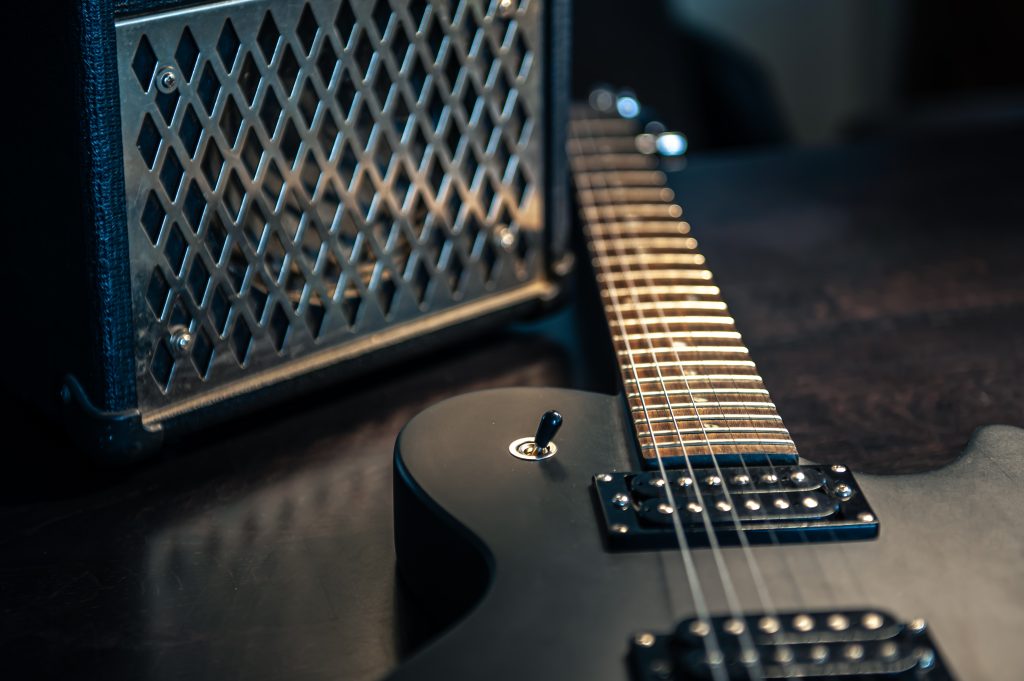Electric guitars are amazing instruments that can be used to create a wide range of sounds. If you’re interested in learning this new instrument, follow these easy steps to play electric guitar and start rocking out today!
Ready to start your electric guitar journey?

The Battle of the Guitars: Electric vs. Acoustic
There are many different types of guitars, but two of the most popular are electric and acoustic. Both have their own unique features and sound, so it can be tough to choose between them. Here is a quick guide to help you decide which one is right for you:
Electric guitars are known for their powerful sound and ability to be plugged into an amplifier. This makes them perfect for Rock and Metal genres, where they can really shred! They tend to be more expensive than acoustics, but they’re definitely worth the investment if you’re serious about your music.
Acoustic guitars have a richer, fuller sound that doesn’t need any extra amplification – making them ideal for folk or country songs. They’re also great for beginners because they’re typically less expensive than electrics (though there are some high-end models that cost just as much).
The Basic Distinction
Some people might wonder what the key differences are between playing electric and acoustic guitar. While there are some similarities, there are also a few key distinctions that set the two apart.

For starters, electric guitars require an amplifier to produce sound. This means that you’ll need to invest in a decent amp before you can really begin playing. You also have access to a variety of effects pedals and amplifiers that can be used to create different sounds.
When it comes to the playing techniques themselves, electric guitar players tend to focus on playing faster and using more advanced techniques such as bends, slides and hammer-ons. On the other hand, acoustic guitar players might rely more on strumming patterns and fingerpicking.
The Common Ground
The great news is that no matter which type of guitar you choose to play, the basics are pretty much the same. You will learn the fretboard in the same way. So fret not!
If you have been learning how to play acoustic guitar, don’t worry — all that time spent will pay off when you expand your skills to include electric. The fact that you already have knowledge in this area will help you develop skills more quickly. You’re at an advantage!
Playing the electric guitar is a natural progression for any musician looking to broaden their skill set and create new sounds.
9 Easy Steps to Play Electric Guitar
No matter what style of electric guitar you’re into, it all starts with a good foundation. Learn some of the basic steps you need to get started playing electric guitar and help make your learning process easier.
Here are some helpful tips for new electric guitar players!
1. Choose the right guitar.
When you’re just starting out, it’s important to find an electric guitar that is comfortable for you to play. If you’re not comfortable, you won’t be able to play as well and you’ll likely get frustrated and give up. There are a few things to consider when choosing a guitar, such as body style, neck shape, and pickup type.
- Solid body guitars – If you’re looking for a guitar that can stand up to some serious rock and metal, these one-piece solid wood guitars are the way to go.
- Semi-hollow body guitars – These guitars have a solid center block with hollow chambers on either side. This gives them a unique sound that is well-suited for jazz, blues and soul music.
- Hollow body guitars – A hollow body guitar is built with a big, deep frame and no solid middle. These guitars have a more mellow sound and are perfect for jazz, blues, and other acoustic genres.
2. Get the right amplifier.
You need an amplifier to make your electric guitar sound louder. When you’re just starting out, it’s important to find an amplifier that is affordable and easy to use.
- Combo amplifiers – A combo amplifier is an all-in-one unit that combines a speaker, power amp, and preamp into one package. These amplifiers are small and portable.
- Head and cabinet – This setup consists of two separate components: the head (or amplifier) and the cabinet (or speakers). If you’re looking for an amp with more features and options that is also stronger and can fill a larger space, then one of these might be the right choice for you.
3. Get the necessary accessories.
To get the most out of your electric guitar, you’ll need some accessories. This includes items like a strap, picks, strings, and a tuner. Most importantly, you need a cable. The amp is completely useless without it!
- Cable – A cable connects the guitar to the amplifier. Even the best guitar and amp won’t work without this!
- Picks – If you want to play electric guitar, especially rock music, you will generally need picks. A thicker guitar pick is more difficult to use, so beginners should start with a thinner or medium pick.
- Strings – Be sure to keep a spare set of strings with you in case your current ones snap or wear out. Electric guitars typically use lighter gauge strings than acoustic guitars.
- Tuner – A tuner is an essential accessory for any guitarist. It will help you to keep your guitar in tune and make sure that you are playing the correct notes.
- Strap – A strap is necessary for playing electric guitar standing up. It will help you keep your hands in the correct position and ensure that you don’t drop your guitar while playing. Even when sitting down, a strap provides stability for the instrument.
4. Find an instructor or mentor.
Having the guidance of someone experienced in playing electric guitar can make all the difference when you’re just starting out. An instructor can guide you in the right direction and give you tips on how to practice effectively.
- Structured lessons – These guitar lessons provide structure, focus and motivation, which makes it easier for beginners to stay on track and make progress.
- Tailored lessons – Finding a mentor that suits your playing style can help you develop your skills more quickly. They can tailor their teaching methods to your individual needs, goals and level of playing. This way, you’re guaranteed to make the most out of your lessons.
5. Learn the basics.
Before you start playing electric guitar, it’s important to learn the basics. This includes learning how to hold the instrument, how to tune the strings, and how to make basic chords. These concepts are essential for playing any type of guitar.
- Open Chords – The simplest type of guitar chords are called open chords. They are relatively easy to play using just the first three frets of the guitar and at least one open string. So-called cowboy chords are a great starting point for beginners.
- Strumming Patterns – Once you know some open chords, it’s time to learn how to use them in songs. Strumming patterns are a great way to add rhythm and emotion to your playing. Start by learning the basics of timing and counting beats, then move on to more complex strumming patterns.
6. Start learning songs.
Now that you have the basics down, it’s time to start learning songs! If you’ve been taking lessons, your teacher can help you pick out easy guitar songs that are suitable for your skill level. Learning how to play songs is a great way to build on the knowledge you’ve gained so far.
7. Play Barre Chords.
Learning how to play barre chords is an important part of playing electric guitar. Barre chords use the index finger to barre (or press down) multiple strings at a certain fret. These chords are more advanced, so they’ll take more finger strength to play. They can produce richer sounds than open chords though.
- E & A Shape – The open chords E and A are the way to start forming barre chords. If you place your index finger over the strings of a fret while forming these two chord shapes, you will see how the shape of the chord changes to create barre chords.
8. Don’t skip over music theory.
Music theory may not be the most glamorous topic, but it is key to becoming a good musician. A strong understanding of music theory will make you a better musician and help you understand how music works.
- String names & numbers – Learn the open strings on a guitar and their numbers. This is essential for playing electric guitar, as you will need to refer to them when playing chords or reading chord charts.
- Musical alphabet & intervals – Knowing the musical alphabet can help you understand basic music theory, such as chord and scale names. Intervals are steps between notes in a scale and can be used to create chords and melodies.
- Scales – Start learning the major scale. This is the foundation of most western music and will help you understand how chords and melodies work together.
9. Practice wisely!
How you practice is just as important as how much you practice. Set aside some time each day to work on specific skills or songs. This will help ensure that your playing improves and that you stay motivated.
- Time – Fifteen minutes of guitar practice every day is better than hours all crammed into one session. Consistency leads to good habits that last longer than those that are only occasionally practiced.
- Goal – Set personal goals to achieve. Maybe it’s mastering your favorite riff or learning to play a certain song. Whatever it is, make sure that you have something to work towards so that you stay motivated and excited about playing guitar!
- Routine – To succeed, you need to establish a good routine. Paying attention to your daily routine will have long-term benefits.
- Learn musical concepts in order – It is important to learn concepts in the correct order. By doing so, you will gain a strong understanding of how things work and be able to apply it more effectively.
- Practice with a metronome – A metronome is a great tool for staying in time. Use it to practice your rhythms and timing, as well as speed exercises.
These steps will help get you off the ground and on your way to becoming an electric guitar master!
Commit to Take Small Steps
If you want to make real progress in your life, it’s important to commit to taking small steps every day.

By taking action consistently, no matter how small, you’ll gradually move closer and closer to your goals. And eventually, those small steps will add up to big results!
We hope you’ve found these tips helpful and that they’ve encouraged you to take the plunge and start learning this amazing instrument. Electric guitars can provide a whole new level of sonic possibilities for your music, so what are you waiting for? Start playing today!




